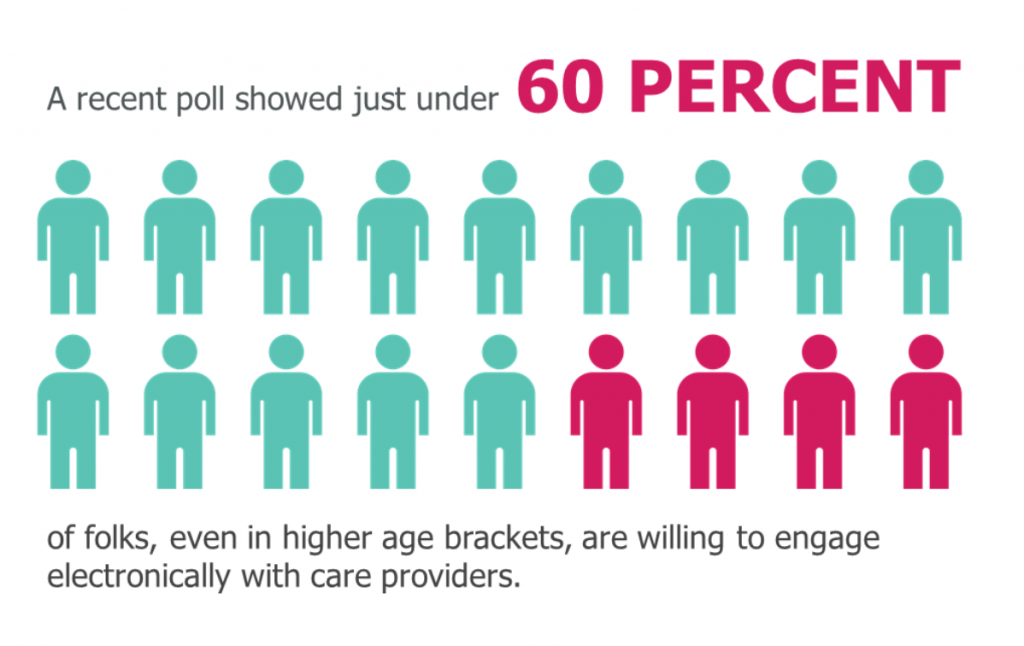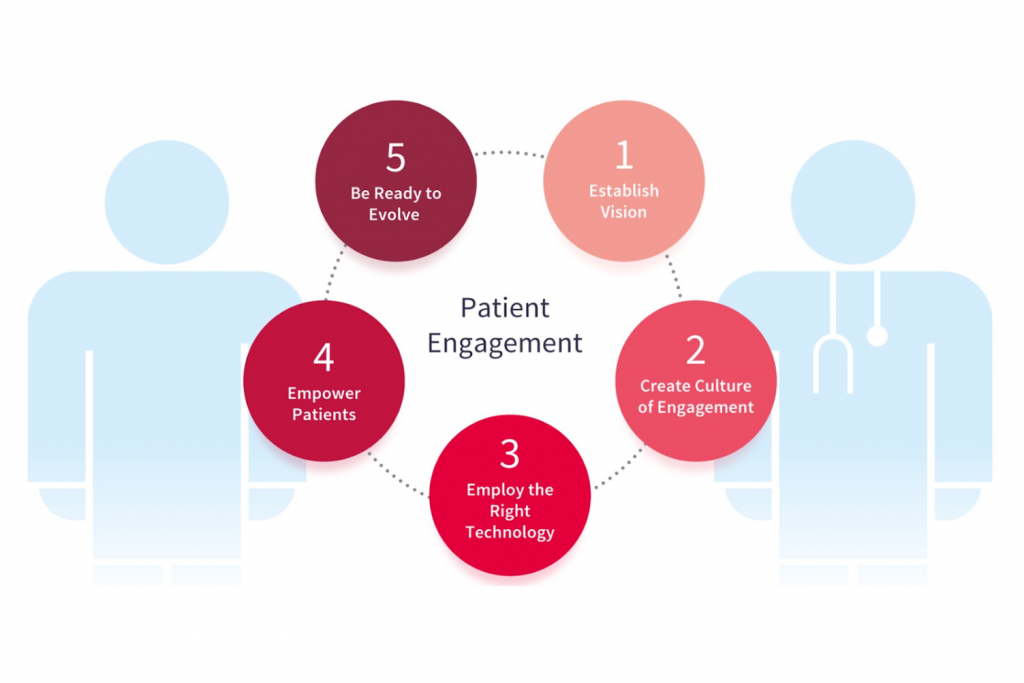Overview of Patient Engagement Software Development Market
2021 was an interesting year for the world in general, and for the Healthcare industry in particular. Everyone felt the devastating impact of the COVID-19 pandemic and experienced at least some stress while adapting to the new normal. For organizations in Healthcare, it became another driver to digitize processes and leverage digital patient engagement tools.
There are already over 300,000 health apps on smartphones, tablets, and computers today. According to the survey by Deloitte, 60% of people are willing to share their private health data from the wearables with doctors, to improve their health. In another survey by Accenture, 60% of respondents claimed that they want to use digital patient engagement solutions for communicating with their doctors and medical institutions.

The global patient engagement solutions market is valued at USD 14.89 billion in 2021 and is expected to grow to USD 37.2 billion by the end of 2026 if Market Data Forecast is to be believed. So, obviously, the market is ready. What about your organization? Let’s talk in great detail about the benefits of digitizing your communication and interaction with patients.
The True Value of Patient Engagement Solutions
What Is Patient Engagement?
This term is used to describe the interaction of the patients with the healthcare services they use. It can be applied to any healthcare setting, including emergency room visits, retail clinics, inpatient care, outpatient care, and many more.
Maintaining the highest levels of patient engagement is extremely important in order to detect diseases early, produce better patient outcomes, and ultimately save people’s lives!
Other benefits include:
- Reducing readmission and redundant tests
- Lowering healthcare costs
- Increasing the speed of medical payments
- Improving adherence to care plans
This is a critical area to cover and strive to make better for any organization in the Healthcare industry.
The difference between Patient Engagement and Patient Experience
On the surface, they might seem similar, but there is a distinction. Patient experience is passive, it is how the patient perceives and receives their care. Engagement is active, something that has a clear interactive component. Both of them are critical in order to improve medical outcomes and deliver effective treatments.
Engagement can be seen as a tool that drives the patient experience, with patients being more involved and connected to healthcare organizations. The more the healthcare organization knows about the patient, the more appropriate services it can offer, bridging the gap between needs and offerings.
What Is Patient Engagement Software?
The technology steps in to improve this relationship even further, as patient engagement software is used by healthcare organizations to automate and improve the communication with patients, providing them with easy access to services when necessary.
In most cases, early versions of such programs were serving the purpose to remind the patients about the appointments with the help of one-way push communication. Today, patient engagement apps have become much more sophisticated and are often referred to as patient engagement platforms due to their broad range of functionality.
The importance of Patient Engagement Systems
In 2022, technology plays a key role in creating consistency and reliability in your organization. You don’t have the luxury to allow human mistakes in your processes when they could be avoided. Additionally, software is superior to human labor, where it could be applied, which will bring you additional cost savings.
The truth is, even the smallest medical practice has a lot of paperwork that can be replaced by automated technology, bringing in much more consistency. If we talk about manual patient outreach, it relies on the availability of staff and can slow down your processes. Not to mention that manual outreach via voice calls is only working when patients actually pick up the phone or listen to their voice.
Digital patient engagement platforms cover much more than the aforementioned basic functions and can become your leverage to survive in the always changing and highly competitive market.
What are the standard features of Patient Engagement Tools?
Whether you want to use an off-the-shelf solution or are ready to find a development team and create patient engagement software from scratch, these are the basic functions your system must have:
- Patient registration
- Management of the patient’s medical history online
- Scheduling and rescheduling appointments
- The ability to send automatic appointment reminders, both with text and voice messages
- Providing patient education with customized content
- Facilitation of online billing and payments

The real risks of not having a Patient Engagement Software solution
What if you decide to not embrace technological innovation? The consequences may negatively impact your organization, not to mention the well-being of patients.
Reduced patient flows
In the competitive environment, your patients expect customized services and personalization in healthcare. According to one of the recent surveys, three-quarters of consumers in the United States of America wish for a more personalized experience in receiving healthcare services.
Worsened patient outcomes
Some adult patients refuse to adhere to the prescribed treatment plans. Skipping planned medication can result in severe consequences or even death for patients. Patient engagement technology has a chance to reduce the number of such unfortunate events by notifying patients on taking prescribed medication and alerting the doctor when the patient is ignoring treatment.
The types of Patient Engagement Systems, and how much do they cost?
If you are on the path of developing a custom patient engagement software solution for your organization, it is important to acknowledge other options as well. Aside from the option to create patient engagement software from scratch, you have two other options: an off-the-shelf solution and a Content Management System (CMS)-based solution. Each of these three options has its own pros and cons, and they differ in prices as well. Let’s break down each of them in the following section.
Off-the-shelf patient engagement solution
The chances are, your case is not unique and there are already available solutions waiting to be implemented in your organization. To pick your option, based on features, reviews, and a pricing model. Some of those solutions have predefined types of subscriptions, but some of them will allow you to select the specific features you require.
Keep in mind that every off-the-shelf platform has its own main focus, so the core specialization may be patient registration software, patient communication software, patient feedback software, e-prescription system, or EHR integration.
You may encounter a wide price range for this software, $100,000-$500,000 a year. There are also additional support, licensing, and customization costs to consider.
The off-the-shelf patient engagement software solution will offer you the fastest start to deployment imaginable. You don’t need to change your infrastructure or make any technical changes to your processes because most of these tools are being deployed from a Cloud as Software-as-a-Service (SaaS). You will still need to adjust your internal workflows to match the new solution. Compared to the other two options, your initial investments will be much lower.
Speaking of scaling, the situation is kind of tricky here. If the software you use has plugins for your new services, the scaling will be fast and easy. However, if your vendor doesn’t have the necessary functionality to cover new areas of interest, you will be limited in diversifying your operations and might need to spend additional time to switch to another software that covers your needs.
The two main disadvantages off-the-shelf solutions have:
- When you require a unique set of features, you can spend a lot of valuable time searching for a vendor and then still not find a proper fit.
- A vendor can discontinue supporting your version at any time, and you can’t do anything about it.
Off-the-shelf software is most suitable for small medical practices with no more than 10 doctors, as well as individual practitioners with limited budgets.

CMS-based Patient Engagement Software Development
So, when existing solutions are not enough, it’s time to create patient engagement software. One of the options is to hire a software development team to deliver a solution based on Content Management Platforms, for example, WordPress or Wix. CMS platforms allow the development of basic functionality, such as patient registration, scheduling, and rescheduling of the appointments, patient education, communication between patients and doctors, EHR integration.
While there is an option to go for a hosted platform like WordPress or Wix that you can adjust yourself, you might be interested in using the open-source version of WordPress and in addition, hire a team of professionals to help you customize it. At the first glance, using hosted platforms look like a solution that will save you money, but you will have to pay according to monthly plans, paying for additional expenses on third-party plugins and different extensions. Yes, you will save on software development experts, but in the end, you will receive only basic functionality with minimal customization.
The self-hosted CMS solution is a far more customizable approach, which will allow you to fulfill your needs much better. The price for building CMS-based patient engagement software with core functionality is around $35,000 and usually is developed within two months. Core functionality includes appointment scheduling, an online payment mechanism, and secure communication between patient and provider.
This core solution can be enhanced with both third-party and custom plugins. The price of building a simple custom plugin with one feature will cost you around $3000. The price of a custom plugin will increase according to the complexity of the function it should bring. The price for a single plugin can even exceed $50,000!
In a nutshell, CMS-based systems can be a good solution without overpaying, but they are very limited in terms of scalability.
Custom Patient Engagement Software Development
It’s all in the name! If you need a solution that will fit your organization like a glove and cover all your needs, this is the only way to go. Unlike off-the-shelf and CMS-based options, in this scenario, you will get complete ownership over the final product. Your software development team or the team of outsourced experts will adjust the solution according to any significant changes in your organization.
You have the power to build custom patient engagement software from the ground up alongside your development partner and to be involved in all key decisions along the way. All technology-related aspects will be driven by your decisions. The type of the web development framework, front-end, and back-end technologies, data visualization format, and everything in between, will be a shared decision with you and your vendor. Because your team will be in full control of the code, the integration with any third-party systems will be much smoother and easier.
The price for a very basic custom solution starts at $50,000 and needs at least three months to be developed. You will get a simple chatbot in addition to standard patient engagement solution features. If you want more sophisticated patient engagement software features, like connecting patient engagement software with health tracking devices to monitor the patient’s condition, more complex chatbots, or implementation of Artificial Intelligence, be ready to pay much more. In fact, the price for an advanced custom solution will start at around $120,000.
To sum it up, with a custom solution, you will receive the maximum amount of features, the highest personalization, more scalability and flexibility compared to other options. You will be in full control of technology and will receive complete ownership of the final product. On the downside, this is the most expensive and time-consuming option, which requires additional costs on supporting personnel.
It makes sense to build your patient engagement software solution if your organization offers a diversified set of services, you plan to scale in the near future, have a necessary budget to start the development process, and don’t want to interrupt any existing workflows.
FAQ
What is Patient Engagement technology?
It is technology, software solutions, and tools that allow better communication between a patient and a doctor or healthcare organization.
What is a Patient Engagement digital strategy?
It is a complex digital strategy by a healthcare organization for improving the communication, interaction, monitoring, and education processes with patients.
What are the types of Patient Engagement Systems?
The three main types include off-the-shelf solutions, CMS-based solutions, and custom-built patient engagement systems.
Final word
While there are still some experts that are skeptical about the importance of patient engagement software, it’s hard to deny the real value that technology brings to healthcare. The future is now, and if you don’t have a patient engagement system already, you need one! The real question is what approach is best for you? Off-the-shelf, CMS-based, or entirely custom-built? All three solutions are viable for different scenarios. For small medical practices that don’t plan to expand much, basic off-the-shelf or CMS-based solutions might suit well. However, if your organization strives to become a market leader, expand into something greater, and have enough funds for technological investments, a custom-built solution is the best option for you!